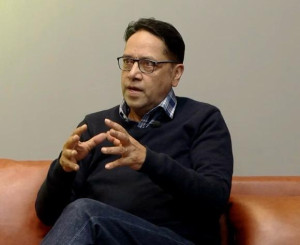Books
Writing stories rooted in culture
Rishi Amatya discusses his first novel and why mythology is the focal point of his writing.
Rishika Dhakal
Rishi Amatya is a writer, researcher, and heritage interpreter based in Mangal Bazaar. His works mainly comprise myth, history and culture. In addition to writing, he has written interactive and self-guided heritage maps for the Patan Museum and Hanuman Dhoka Museum. Radha: Wrath of the Maeju is his debut novel.
In an interview with the Post’s Rishika Dhakal, Amatya discusses his first novel and why mythology is the focal point of his writing.
How did you get into reading and writing?
My mother was a primary school teacher and an avid reader, creating a home environment that encouraged reading. Our house was filled with a variety of books and magazines, such as Muna Patrika, Madhupark, and Yuwa Manch. Additionally, my friends and cousins had extensive collections of comic books, which further nurtured my reading habit.
My writing journey began with my love for reading. After completing my SLC (now SEE), I started writing and took on various freelance writing jobs, including writing for websites. I wrote for a children’s magazine, ‘Young Harold’, covering different events. However, it wasn’t until 2006 that I began writing professionally. I contributed to Wave magazine, ECS and other publications, covering issues related to youth and culture.
What is your first novel ‘Radha: Wrath of the Maeju’ about?
The story centres on a girl named Radha, who once served as the Royal Kumari of Patan. As Kumari, she was confined to the Kumari Bahal, isolated from the outside world.
After being dethroned, Radha longs to visit Mangal Bazaar and experience life as a normal girl. However, her world is shattered when an earthquake strikes, releasing demonic forces from another realm. These demons target Radha and her family. The book follows Radha’s struggle to do the right thing as she finds the courage to protect her family and the world she lives in.
Do you follow any routines when you sit down to write?
I try to write every day. When working on a piece, I aim to write 500-1000 words daily while drafting or writing a scene. I start writing whenever I have free time, striving to maintain consistency in my daily writing routine. Meeting deadlines demands extensive writing, so it’s essential to keep a steady writing schedule.
How did you develop the characters of your novel? Are they purely fictional?
All three main characters in my book are fictional, but they reflect people I’ve interacted with and dealt with in real life. Some of them are inspired by specific events in my life.
Why did you choose to write on mythology?
I aimed to create a story deeply rooted in our culture. Most fiction we read today is based on Western cultures, like Norse or Egyptian mythology.
We often overlook Nepal’s rich and fantastic mythologies. We don’t revere our mythologies with the same reverence as Western ones. Additionally, there aren’t many literary works that interpret our society. I’ve always wondered what it would be like to set fiction in our Kathmandu Valley.
To fill this gap, I crafted my book’s story to reflect our society’s current context, culture and our experiences as its people.
What would you say to young writers?
To excel in writing, it’s essential to keep reading and writing regularly. Exploring a wide range of books, both within and beyond your interests, can greatly enhance your writing skills.
Reading books related to your field can significantly improve your writing process. Additionally, it’s important not to second-guess yourself or worry that your writing isn’t good enough. Self-censorship can hinder progress, so it’s crucial to write freely and confidently.
What inspires you to write?
I don’t have a specific individual as my source of motivation. Instead, I find inspiration in every author I’ve read. However, while working on my recent book, I was particularly inspired by the works of Terry Pratchett and Neil Gaiman.
Terry Pratchett’s Discworld novel series stands out as particularly satisfying. The series centres around a young protagonist and the evolution of this character is the most interesting part. Overall, I draw inspiration from the diverse range of authors I've read.
What difficulties did you face while publishing the novel?
One major hurdle I encountered while writing my book was the absence of editorial support. Fortunately, my publisher provided some editorial assistance. However, in general, securing editorial support remains a significant challenge for authors. Additionally, limited platforms are available for authors like myself to showcase our work.
Rishi Amatya’s book recommendations
Boxers and Saints
Author: Gene Luen Yang
Publisher: First Second Books
Year: 2023
The book tells the story of China’s boxing revolution. Its stories are told from the perspectives of Chinese boxers, mainly about anti-imperialism. The writing in the book is easy to read and engaging.
The Sandman Series
Author: Neil Gaiman
Publisher: DC Comics
Year: 1988
There are very few books that have captivated me like this one. The author weaves together fantasy themes while borrowing elements from various myths, such as Norse and Egyptian, making it interesting.
The Wee Free Men
Author: Terry Pratchett
Publisher: Doubleday
Year: 2003
The book is centred on Tiffany Achin's story. It inspired me to write my first novel, Radha. The author’s development and enhancement of Tiffany’s character as the story progresses are commendable.
The Adventures of Amina al-Sirafi
Author: Shannon Chakraborty
Publisher: Harper Voyager
Year: 2023
This book, set in the 11th century, features a strong female protagonist who is a pirate. The Adventures of Amina al-Sirafi also provides a description of Islam, its mythology, worldview, etc.
The Kaiju Preservation Society
Author: John Scalzi
Publisher: Tor Books
Year: 2022
This book is a science fiction novel about Kaiju. The protagonist loses his job after the epidemic and has to go to a different world to locate Kaizus. The world it discusses appears to be the same as the one we live in.




 13.12°C Kathmandu
13.12°C Kathmandu











